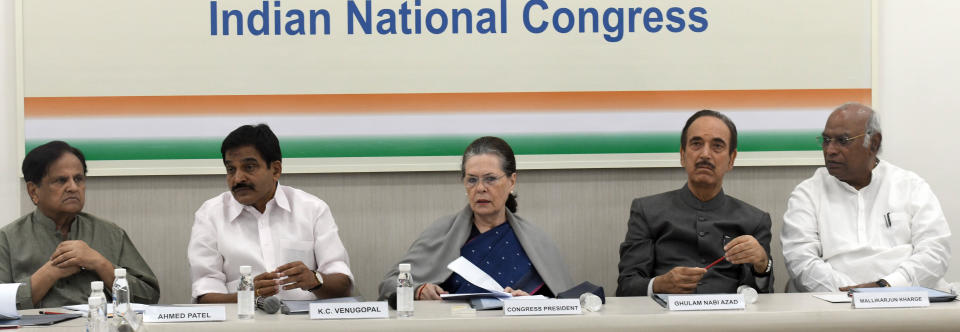The story behind mini-revolt against Sonia Gandhi in Congress
On May 25, 2019, a day after the Congress copped another abject drubbing at the hustings in the general elections at the hands of incumbent Narendra Modi-led Bharatiya Janata Party, then party president Rahul Gandhi resigned from the post and recommended that a non-Gandhi should occupy the top post in the Grand Old Party.
While a section of Congress leaders and supporters, tacitly or in private, applauded his statement, many were of the opinion that he should continue as the president. But the Congress scion remained stubborn, even as his sister, Priyanka Gandhi Vadra, accused top party leaders of not fully supporting her brother in attacking the incumbent government and Prime Minister Narendra Modi over the Rafale issue.
After a couple of months of rumblings within the party, Sonia Gandhi, who had earlier been the party president from 1998 to 2017, took over as the interim president in August 2019 at the fervid beseeching of her loyalists. This was meant to be a temporary, stop-gap arrangement. But the arrangement lasted for more than a year and sowed the seeds of discontentment within the rank and file of the Congress.

During this period, the Congress meekly let its state government in Madhya Pradesh fall by the wayside in the face of offensive by the BJP. The defection of Jyotiraditya Scindia also landed a shattering blow to the party.
It was followed by a protracted political brouhaha in Rajasthan spawned by the acrimonious tussle between the state’s chief minister and senior Congress leader Ashok Gehlot and his then deputy Sachin Pilot. The Congress just about managed to prevent Pilot’s exit, at least for the time being, but the fissures within the party and the ineptitude of torpid leadership became flagrantly conspicuous.
It culminated into 23 Congress leaders, across age groups and regions, writing a dissenting letter to the High Command on August 7, 2020, which demanded a ‘full-time visible leadership’ and complained about a drift in the party. It also highlighted ‘uncertainty in leadership’. Shashi Tharoor, Ghulab Nabi Azad, Kapil Sibal, Mukul Wasnik, Manish Tewari, Anand Sharma, Milind Deora, among others, were the signatories to the letter.
The idea of letter reportedly germinated at a dinner hosted by Tharoor at his residence five months ago. It was attended by a host of prominent leaders, many of whom are signatories of the letter, and they discussed critical issues, including that of leadership, plaguing the party. Among those, who were present at the party but didn’t sign the letter, are P Chidambaram and Sachin Pilot.
An embattled Congress leadership first denied the existence of any such a letter, but later when it was leaked to the media and the dissenting voices went public, the Congress Working Committee meeting was convened on August 24, 2020, to discuss the contents of the letter and address the issue at hand. Some hopefuls within the party and in the media thought that it could lead to the change of guard. But a watertight script had already been prepared.
Ahmed Patel, the staunchest Sonia Gandhi loyalist and her political secretary from 2001 to 2017, called up an array of senior leaders before the meeting and implored them to stand by her during her ‘ill health’. The emotional entreat also included the request to ‘not upset her further’.
His plea to the CWC members fructified as per the script as Sonia offered to resign from the post. But her loyalists jumped to her defence. Kumari Selja dubbed the 23 leaders, who wrote the letter, as ‘BJP agents’. KC Venugopalan called the letter ‘cruel’, while Ambika Soni demanded punitive measures against the signatories of the letter. Congress chief ministers - Ashok Gehlot, Amarinder Singh and Bhupesh Baghel - threw their weight firmly behind the ailing Sonia and urged her to stay on as the president in the time of crisis.
In the wake of emotional pitch and pleas by a retinue of leaders, Sonia changed her mind and agreed to extend her tenure as an interim president. She even displayed magnanimity and, on the face of it, decided to ‘forgive’ those who had written the letter. “I have no ill-will or any negativity towards those who wrote the letter. It is their right. What is wrong and what hurt me was that the letter was leaked to the media,” she said.
Thus, the mini-revolt which threatened to dethrone the Gandhis from highest post was neatly and skillfully thwarted. Wasnik, considered close to Rahul, even tendered an apology for being a signatory to the letter. However, Azad and Sibal, long-time Gandhi family loyalists, made their displeasure public at the ‘BJP agents’ jibe. Even Mani Shankar Aiyar publicly pronounced that he would have also signed the letter as well had he been approached.
While the signatories of the letter fear a backlash and repercussions for raising a ‘banner of revolt’, the list of leaders feeling discontented and disconnected with the party leadership is rapidly burgeoning.
The mini-revolt may have been crushed for some time but the embers of the rebellion are burning bright in broad daylight.
Follow the author on Twitter (@navneet_mundhra)

 Yahoo Sport
Yahoo Sport 





































